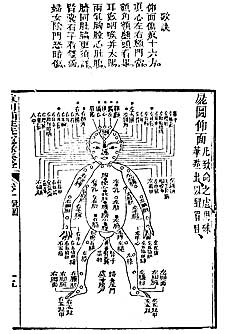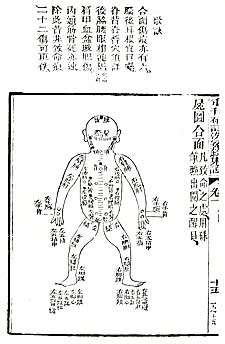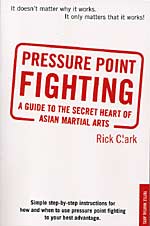Delayed Death Touch: Instructions to the Coroner of China Reveal
Knowledge of Vital Points
By Rick Clark
Among the joys of researching a topic in depth are the little gems of
knowledge you often uncover. Several years back I came upon a reference
to a manuscript that was translated by Herbert Giles. One of the reasons
this caught my eye was his name, Herbert Giles. He was one of the men
responsible for developing the Romanization of Chinese (one of the two
most used methods of translating Chinese pronunciation to Western spelling
known as Wade-Giles).
Then there was the title, “Instructions to the Coroner” or “Records
of the Washing Away of Unjust Imputations”. With a Masters degree
in Criminology I began to wonder what type of forensic information might
be discussed in an old Chinese manuscript. The “His Yuan Lu” dates
from the reign of Shun Yu (1241 – 1253) and was written by Sung
Tzhu. Giles first came across this work while stationed at Ningpo in
1873 and subsequently translated this text. It was then published in
the “China Review” in 1874 and later republished in the “Proceedings
of the Royal Society of Medicine” in 1924.
Once I acquired a copy of the translation I quickly scanned the text,
and to my pleasure there were two charts showing vital points! Now here
indeed was something to look at. A text that dated from the mid 1200’s,
translated into English in 1874 that clearly addressed vital points.
This may be the earliest text in the English language that mentions vital
points. Consider the fact that the “His Yuan Lu” made available
to us information on vital points forty eight years prior to the introduction
of Karate into Japan by Gichin Funakoshi in 1922. Also, remember there
are a number of books published in the early 1900’s that clearly
discuss and demonstrate the use of vital point techniques.
 |
 |
With this in mind, the contents of this work become immediately provocative.
The information given on vital points was limited, but clearly presented.
There are two charts which show vital points on the front and back
of the body. According to the text there are sixteen vital points on
the
front of the body (twenty two if you count them as bi-lateral) and
six vital points on the back (twelve if counted as bi-lateral) for a
total
of thirty two vital points on the human body.
In addition there are thirty six non-vital spots listed on the front
of the body and an additional twenty listed on the back. Although this
was an early work, there are records of earlier books that have been
lost describing the injuries that could be caused on another person by
a trained fighter.
They are: “I Yu Chi” (Records of Doubtful Criminal cases)
written in the 10th century by Ho Ning and Ho Meng, and the “Ming
Yuan Shih Lu” (True Records of the Clarification of Wrongs) by
Hsu Chih Tshai in the 6th century. Considering that the Shaolin monastery
(to which many forms of Chinese martial arts trace their lineage) goes
back to the 5th century, one could make a very tenuous assumption that
Ho Ning, Ho Meng, and Hsu Chih Tshai could have had knowledge of the
damage that trained individuals could inflict on one another without
the use of weapons.
“His Yuan Lu” recognized
two classes of vital points: those that could be fatal on
impact and those that could cause death at a later date.” |
|
In China there were two main sources of knowledge (or
tradition) in the martial arts. The Shaolin temple is the one most people
immediately associate
with the fighting arts of China due to the television series “Kung-Fu”.
However, there was another temple, Wudang, which followed the Taoist
tradition. This temple has gained fame with the general public from the
movie “Crouching Tiger, Hidden Dragon”. Because of its age the “His Yuan Lu” may be one of the oldest
books on forensic medicine ever written. This book was carried by the
high territorial official who had the duty to act as coroner whenever
they had to investigate a death. It is interesting to note that inquests
were also held on the living if a person sustained a dangerous wound.
This was done to establish a “death limit”. According to
the “His Yuan Lu,” the wounded man in a brawl would be handed
over to the accused to be nursed back to health. If the victim died as
a result of the injuries suffered in the fight, the aggressor would be
subject to a death penalty.
The author of the “His Yuan Lu” recognized two classes of
vital points: those that could be fatal on impact and those that could
cause death at a later date. The text notes that if a mortal wound is
given to the top of the head, behind the ear, the throat, or the pit
of the stomach death can take place quickly. Or, death can result in
three days if a vital point located at the back of the head, the forehead,
or the chest is struck. Then there are also “ordinary” vital
points, which if struck can result in death within as long as 10 days.
From a practical point of view the vital points that result in immediate
death would have been of the most interest to the warriors of those days,
and even to the current day martial artist. In practical terms of self-defense,
you would want to have an immediate reaction from strikes to vital points,
rather than delayed effects. However, there may be some advantage to
striking a person and having him die ten days hence: it might allow an
individual to escape notice as being the perpetrator of a fatality.
It is interesting to read that fatal wounds resulted from blows delivered
by the hands to the upper part of the body, the back, chest, and upper
ribs and rarely on the lower ribs. Kicks would have been delivered to
the pit of the stomach and the ribs. The author of “His Yuan Lu” believed
that certain blows to the head, face, chest, breast, etc. could have
mortal consequences. The author noted that if a blow resulted in the
death of an individual at a later date, Coroners should look for somewhat
larger bruising and inflammation. If the blow resulted in immediate death,
then there would be deeper and more severe bruising.
This may be where some of the lore on the delayed death touch could
have first surfaced. From a purely western point of view it is possible
to understand how death could occur at a time later than the original
altercation. For example, if you rupture the spleen or liver, you would
not be able to survive unless you were taken to the hospital and surgery
performed. At the very least severe infection might occur that could
cause death. So it seems that the Coroners of China were well aware of
the use of vital points and how they could result in the death of an
individual either at the time of the assault or at a later date.
About The Author:
Rick Clark specializes in the study of vital point applications
within traditional martial art techniques and teaches vital points seminars
throughout the world. He has published numerous articles and books on
the subject and has just published "Pressure Point Fighting: A guide
To The Secret Heart Of Asian Martial Arts," published by Tuttle.
He can be contacted at 3099 E. Dallas Rd., Terre Haute IN, 47802, or
via e-mail at rick.aodenkou@verizon.net and
his website is www.ao-denkou-kai.org. Rick has been a frequent contributor
to FightingArts.com.
Rick Clark's Book "Pressure Point
Fighting"
is available from the FightiingArts Estore.

FTB-BP-1100
$19.95
(+$5 Shipping with the US)

|
Pressure Point Fighting
A Guide To The Secret Heart Of Asian Martial Arts
By Rick Clark
This is a straight forward, basic, use-what –works approach to pressure
points and use of kata applications in fighting and self-defense. Clark doesn’t
overwhelm you with theory of Chinese qi, meridians or western neurology.
He just demonstrates technique and where to hit, body position and grappling
skills – things that make the kata you have been practicing come alive
and that provides the missing ingredients in so many people’s training.
In the forward, Jane Hallander writes, “In my fifteen years as a martial
arts journalist, I have seldom seen a martial artist with the ability and
knowledge of Rick Clark, a person who not only knows several martial arts
from all angles, but who can write about them in a manner anyone can easily
understand.” You might also recognize Clark’s name from several
of his articles on this site.
|
|
|